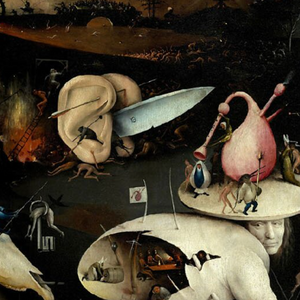In one scene, fantastic creatures, oversized fruit, bulbous egg-shaped dens, and futuristic palaces set the stage for a playful landscape, lush, green, with flowing waterways, and filled with joyous nude figures self-absorbed in innocent sexual activities. In another scene, a dark hell-scape, the figures have fallen into eternal damnation, succumbed to temptation. In this scene, an ear is prominently featured with auricular points treating... what else, but sexual desire.
The Garden of Earthly Delights, painted by Hieronymous Bosch (born Jheronimus, e.g. Jerome, van Aken) circa 1500 A.D., offers a playful awareness of the ear, and acupuncture — which, it is now taken for granted, is neither just the next big modality, nor just an ancient Chinese medicine, but a part of human culture found throughout the world including ancient Egypt, Arabia, Brazil, South Africa, and Eastern Siberia and Northern Canada.[1] Many practitioners of ear acupuncture, including the key developers of auriculotherapy and auriculomedicine, specifically, Paul Nogier, MD, and his colleague René Bourdiol, MD, have studied the curious depiction of ear acupuncture in the Garden of Earthly Delights, an expression of sexual desire arguably also as old as culture itself.
Intrigued in the possibility that the painting could provide ideas concerning auricular points related to sexuality, Nogier and Bourdiol agreed to try this treatment on their patients.[2] Following the painting, in which a right ear and a left ear are joined together along their mastoid surfaces with a knife (representative of a phalus) projecting from the space between the ears, Nogier and Bourdiol tested the points depicted. They followed the guidance of a needle possibly left behind from a piercing by the demon-like figure standing in the inferior concha to discover points with respective surpassing and enhancing effects on libido.[2] These points — the association and location of which are complicated by Nogier’s phase system which has fallen out of use and may not correspond with concepts in contemporary auricular practice — have been reviewed in detail by Nader Soliman, who upon further examination of the painting has suggested there an axis of sexual desire.[2]
From the massaging, prodings, and piercings of demons observed in Bosch’s Garden of Earthly Delights, Soliman has presented an axis of points reflecting our neurology as it relates to sexual function. An axis with effects on the hypothalamus, the cingulate gyrus, the hippocampus, the sympathetic fibers of the sympathetic chain, the parasympathetic fibers in the sacrococcygeal segment of the spinal cord, the cerebellum and more. Regions which have been shown to play important roles[3,4,5] in pathways that either suppress or boost sexual desire.







Comments